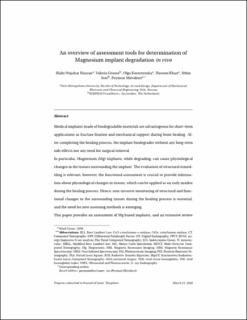| dc.description.abstract | Medical implants made of biodegradable materials are advantageous for short-term applications as fracture fixation and mechanical support during bone healing. After completing the healing process, the implant biodegrades without any long-term side effects nor any need for surgical removal. In particular, Magnesium (Mg) implants, while degrading, can cause physiological changes in the tissues surrounding the implant. The evaluation of structural remodeling is relevant, however, the functional assessment is crucial to provide information about physiological changes in tissues, which can be applied as an early marker during the healing process. Hence, non-invasive monitoring of structural and functional changes in the surrounding tissue during the healing process is essential, and the need for new assessing methods is emerging. This paper provides an assessment of Mg based implants, and an extensive review of the literature is presented with the focus on the imaging techniques for investigation of the Mg implants’ biodegradation. The potential of a hybrid analysis, including Near-Infrared Spectroscopy (NIRS) and photoacoustic imaging (PAI) technology, is further discussed. A hybrid solution may play a significant role in monitoring implants and have several advantages for monitoring tissue oxygenation in addition to tissue’s acidity, which is directly connected to the Mg implants degradation process. Such a hybrid assessment system can be a simple, ambulant, and less costly technology with the potential for clinically monitoring of Mg implants at site. | en_US |

